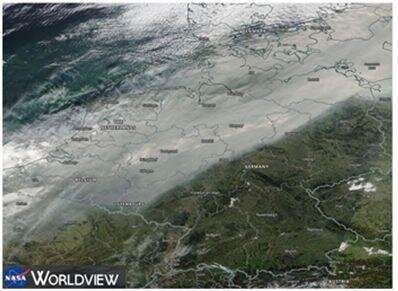The satellite image from October 17, 2017 shows an aerosol cloud over Germany that was caused by forest fires in Spain and Portugal. Credit: worldview.earthdata.nasa.gov
High up in the atmosphere, even the smallest particles lead to the formation of clouds. Air flows that carry Sahara dust to Europe also affect our weather. In the PermaStrom research project, a joint research team from Karlsruhe Institute of Technology (KIT), German Weather Service (DWD), and Meteocontrol, a solar energy service provider, is investigating how to better account for such events in weather forecasts. The insights gained from the project should help make more precise yield forecasts for photovoltaic systems. The German Federal Ministry for Economic Affairs and Energy funds this project with 2.5 million euros.
Highly accurate weather forecasts not only help us plan our weekend trips, but are also crucial for power grid management. This is due to the fact that yield forecasts of photovoltaic systems are based on the predictions of solar irradiance. Extensive forest fires or the episodic transport of Sahara dust to Europe can, however, lead to clearly false predictions of solar irradiance on individual days. Transported by ash, dust, and grains of sand, tiny particles enter the atmosphere, contributing to cloud formation. If the photovoltaic yield predictions are incorrect, the missing energy must be provided temporarily by other means.
"For the studies we use both measurement data from weather stations and data provided by satellites," says Bernhard Vogel, head of the Aerosols, Trace Gasses and Climate Processes group at the KIT Institute of Meteorology and Climate Research—Department Troposphere Research. This data is then processed in an advanced numerical weather forecasting system that DWD operates especially for this application.
In the predecessor project, PerduS, the researchers already investigated the transport of Sahara dust to Germany and were finally able to improve the predictions in this respect. However, according to the experts, this is not enough. They find it necessary to consider other types of aerosols, such as soot and dust originating from forest fires, and to model and predict the effects of these aerosol particles on cloud formation. "Especially the latter is still a challenge because we have not yet fully understood the processes happening in clouds and their interaction with aerosol particles," says Axel Seifert from DWD.
By combining the data from observations and improved modeling based on physics with the ICON-ART modeling system, the scientists hope to make progress in understanding these relationships and to achieve a tangible improvement in daily weather forecasts. In this way, they might also find out whether clouds during a Sahara dust event are really different and if so, whether this difference is due to the aerosol particles themselves.
Within the framework of the PermaStrom project, Meteocontrol GmbH is developing the forecasting system, taking the requirements of grid operators into account. "Thus, the power grid operators can implement the results of our research in the form of new forecasting models," states a representative of Meteocontrol GmbH. The solar energy service provider develops and provides professional monitoring and control systems for PV systems and portfolios. In addition, the company makes solar energy predictions and creates energy and weather data analyses.
In order to ensure that the users of the new forecasts, which are especially optimized for energy meteorology, are involved in the development at an early stage, the project is being accompanied and supported by the associated partners, Amprion, 50Hertz, and EnBW.
Provided by Karlsruhe Institute of Technology
























